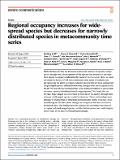Files in this item
Regional occupancy increases for widespread species but decreases for narrowly distributed species in metacommunity time series
Item metadata
| dc.contributor.author | Xu, Wu-Bing | |
| dc.contributor.author | Blowes, Shane A. | |
| dc.contributor.author | Brambilla, Viviana | |
| dc.contributor.author | Chow, Cher F. Y. | |
| dc.contributor.author | Fontrodona-Eslava, Ada | |
| dc.contributor.author | Martins, Inês S. | |
| dc.contributor.author | McGlinn, Daniel | |
| dc.contributor.author | Moyes, Faye | |
| dc.contributor.author | Sagouis, Alban | |
| dc.contributor.author | Shimadzu, Hideyasu | |
| dc.contributor.author | van Klink, Roel | |
| dc.contributor.author | Magurran, Anne E. | |
| dc.contributor.author | Gotelli, Nicholas J. | |
| dc.contributor.author | McGill, Brian J. | |
| dc.contributor.author | Dornelas, Maria | |
| dc.contributor.author | Chase, Jonathan M. | |
| dc.date.accessioned | 2023-03-17T09:30:08Z | |
| dc.date.available | 2023-03-17T09:30:08Z | |
| dc.date.issued | 2023-03-16 | |
| dc.identifier | 283776412 | |
| dc.identifier | a26cb809-603b-4a69-aba4-354c2a7f713e | |
| dc.identifier | 85150314849 | |
| dc.identifier.citation | Xu , W-B , Blowes , S A , Brambilla , V , Chow , C F Y , Fontrodona-Eslava , A , Martins , I S , McGlinn , D , Moyes , F , Sagouis , A , Shimadzu , H , van Klink , R , Magurran , A E , Gotelli , N J , McGill , B J , Dornelas , M & Chase , J M 2023 , ' Regional occupancy increases for widespread species but decreases for narrowly distributed species in metacommunity time series ' , Nature Communications , vol. 14 , 1463 . https://doi.org/10.1038/s41467-023-37127-2 | en |
| dc.identifier.issn | 2041-1723 | |
| dc.identifier.other | Jisc: 962560 | |
| dc.identifier.other | publisher-id: s41467-023-37127-2 | |
| dc.identifier.other | manuscript: 37127 | |
| dc.identifier.other | ORCID: /0000-0001-9687-0593/work/131122725 | |
| dc.identifier.other | ORCID: /0000-0002-0036-2795/work/131122942 | |
| dc.identifier.other | ORCID: /0000-0002-1020-8409/work/131123463 | |
| dc.identifier.uri | https://hdl.handle.net/10023/27210 | |
| dc.description | Funding: W.B.X., S.A.B., J.M.C., R.v.K., and D.M. were supported by the German Centre for Integrative Biodiversity Research (iDiv) Halle-Jena-Leipzig, funded by the German Research Foundation (DFG FZT-118, 20254881); B.J.M. was supported by NSF EPSCOR Track II 201947 and USDA Hatch grant (MAFES #1011538); N.J.G was supported by NSF EPSCOR Track II 201947; I.S.M. was supported by the European Union’s Horizon 2020 research and innovation program under Marie Sklodowska -Curie grant (no. 894644); H.S. was supported by Japan Society for the Promotion of Science (JP19K21569 and JP21H03402); A.E.M. and M.D. were supported by Leverhulme Trust (RPG-2019-402). A.F.E acknowledges the Fisheries Society of the British Isles Studentship. BioTIME used here was supported by ERC AdG 250189 and PoC 727440 (to A.E.M.), and Leverhulme Trust Research Centre–the Leverhulme Centre for Anthropocene Biodiversity (to M.D.). | en |
| dc.description.abstract | While human activities are known to elicit rapid turnover in species composition through time, the properties of the species that increase or decrease their spatial occupancy underlying this turnover are less clear. Here, we used an extensive dataset of 238 metacommunity time series of multiple taxa spread across the globe to evaluate whether species that are more widespread (large-ranged species) differed in how they changed their site occupancy over the 10–90 years the metacommunities were monitored relative to species that are more narrowly distributed (small-ranged species). We found that on average, large-ranged species tended to increase in occupancy through time, whereas small-ranged species tended to decrease. These relationships were stronger in marine than in terrestrial and freshwater realms. However, in terrestrial regions, the directional changes in occupancy were less extreme in protected areas. Our findings provide evidence for systematic decreases in occupancy of small-ranged species, and that habitat protection could mitigate these losses in the face of environmental change. | |
| dc.format.extent | 11 | |
| dc.format.extent | 1564499 | |
| dc.language.iso | eng | |
| dc.relation.ispartof | Nature Communications | en |
| dc.subject | QH301 Biology | en |
| dc.subject | DAS | en |
| dc.subject | SDG 14 - Life Below Water | en |
| dc.subject | SDG 15 - Life on Land | en |
| dc.subject | MCC | en |
| dc.subject.lcc | QH301 | en |
| dc.title | Regional occupancy increases for widespread species but decreases for narrowly distributed species in metacommunity time series | en |
| dc.type | Journal article | en |
| dc.contributor.sponsor | European Commission | en |
| dc.contributor.sponsor | European Research Council | en |
| dc.contributor.sponsor | European Research Council | en |
| dc.contributor.sponsor | The Leverhulme Trust | en |
| dc.contributor.sponsor | The Leverhulme Trust | en |
| dc.contributor.institution | University of St Andrews. Centre for Biological Diversity | en |
| dc.contributor.institution | University of St Andrews. School of Biology | en |
| dc.contributor.institution | University of St Andrews. Scottish Oceans Institute | en |
| dc.contributor.institution | University of St Andrews. Institute of Behavioural and Neural Sciences | en |
| dc.contributor.institution | University of St Andrews. St Andrews Sustainability Institute | en |
| dc.contributor.institution | University of St Andrews. Centre for Research into Ecological & Environmental Modelling | en |
| dc.contributor.institution | University of St Andrews. Fish Behaviour and Biodiversity Research Group | en |
| dc.contributor.institution | University of St Andrews. Marine Alliance for Science & Technology Scotland | en |
| dc.identifier.doi | 10.1038/s41467-023-37127-2 | |
| dc.description.status | Peer reviewed | en |
| dc.identifier.grantnumber | 894644 | en |
| dc.identifier.grantnumber | 250189 | en |
| dc.identifier.grantnumber | 727440 | en |
| dc.identifier.grantnumber | en | |
| dc.identifier.grantnumber | ORPG-8061 | en |
This item appears in the following Collection(s)
Items in the St Andrews Research Repository are protected by copyright, with all rights reserved, unless otherwise indicated.

